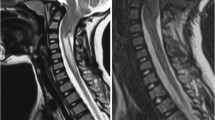Abstract
Introduction
The diagnosis of Chiari I malformation, its symptomatology, and the results of its surgical management are still discussed. We report a pediatric series of CMI without associated skull base malformations or cerebellar growth anomalies operated between 2001 and 2018.
Material and methods
Ninety-one children out of 146 surgically treated cases have been included in the study. Age at surgery ranged from 5 months to 17 years clinical data, and complementary examinations leading to the surgical indication have been analyzed together with the surgical outcomes. The average follow-up duration was of 4 years. The occipito-cervical decompression with duraplasty without opening the arachnoid was the procedure of election. Three quarters of patients presented with headaches, 12% with cerebellar syndrome, 13% with vertigo, 26% with nausea or vomiting, 24% with sensorimotor deficits, 11% with cranial nerve deficits, and 29% with other symptoms. Eighteen percent of patients suffered from scoliosis, 47% had an associated syrinx and 16% a ventricular dilation.
Results
After the treatment, the clinical symptomatology improved in about three-quarters of the patients: headache (69.4%), nausea or vomiting (66.7%), sensorimotor deficits (55.6%), and other symptoms (78.3%). Syringomyelic cavities diminished partially in size or disappeared in 58.3% of patients, remained stable in 29.2%, and worsened in 12.5%. Only one-third of children with preoperative scoliosis benefited from the surgical treatment. No clinical signs or symptoms were found to be reliable predictors of surgical success, neither the extent of the cerebellar tonsil descent.
Conclusion
Occipito-cervical decompression allows to improve the clinical condition in the majority of children with symptomatic CMI in the absence of associated cervico-spinal junction alterations, craniosynostosis, or cerebellar growth anomalies. No clinical signs or symptoms neither radiological criterion appear to be a specific finding for the surgical indication.




Similar content being viewed by others
References
Beretta E, Vetrano IG, Curone M et al (2017) Chiari malformation-related headache: outcome after surgical treatment. Neurol Sci 38:95–98. https://doi.org/10.1007/s10072-017-2950-5
Caldarelli M, Novegno F, Vassimi L, et al (2007) The role of limited posterior fossa craniectomy in the surgical treatment of Chiari malformation Type I: experience with a pediatric series. J Neurosurg 106:187–195. https://doi.org/10.3171/ped.2007.106.3.187
Di Rocco C (2019) Should we stop using the term “malformation” for Chiari type I? Childs Nerv Syst 35:1649–1650. https://doi.org/10.1007/s00381-019-04311-z
Gad KA, Yousem DM (2017) Syringohydromyelia in patients with Chiari I malformation: a retrospective analysis. AJNR Am J Neuroradiol 38:1833–1838. https://doi.org/10.3174/ajnr.A5290
Gluncic V, Turner M, Burrowes D, Frim D (2011) Concurrent Chiari decompression and spinal cord untethering in children: feasibility in a small case series. Acta Neurochir (Wien) 153:109–114; discussion 114. https://doi.org/10.1007/s00701-010-0811-6
Gobel H 7.7 Headache attributed to Chiari malformation type I (CM1). In: ICHD-3 The international classification of headache disorders 3rd edition. https://ichd-3.org/7-headache-attributed-to-non-vascular-intracranial-disorder/7-7-headache-attributed-to-chiari-malformation-type-i-cm1/. Accessed 20 Dec 2020
Grangeon L, Puy L, Gilard V et al (2018) Predictive factors of headache resolution after Chiari type 1 malformation surgery. World Neurosurg 110:e60–e66. https://doi.org/10.1016/j.wneu.2017.10.070
Greenlee JDW, Donovan KA, Hasan DM, Menezes AH (2002) Chiari I malformation in the very young child: the spectrum of presentations and experience in 31 children under age 6 years. Pediatrics 110:1212–1219. https://doi.org/10.1542/peds.110.6.1212
Gripp KW, Rauen KA (1993) Costello syndrome. In: Adam MP, Ardinger HH, Pagon RA et al (eds) GeneReviews®. University of Washington, Seattle, Seattle (WA)
Hidalgo ET, Dastagirzada Y, Orillac C et al (2018) Time to resolution of symptoms after suboccipital decompression with duraplasty in children with Chiari malformation type I. World Neurosurg 117:e544–e551. https://doi.org/10.1016/j.wneu.2018.06.073
Hidalgo JA, Tork CA, Varacallo M (2020) Arnold Chiari malformation. In: StatPearls. StatPearls Publishing, Treasure Island (FL). http://www.ncbi.nlm.nih.gov/books/NBK431076/
Kennedy BC, Kelly KM, Phan MQ et al (2015) Outcomes after suboccipital decompression without dural opening in children with Chiari malformation Type I. J Neurosurg Pediatr 16:150–158. https://doi.org/10.3171/2014.12.PEDS14487
Lu VM, Phan K, Crowley SP, Daniels DJ (2017) The addition of duraplasty to posterior fossa decompression in the surgical treatment of pediatric Chiari malformation type I: a systematic review and meta-analysis of surgical and performance outcomes. J Neurosurg Pediatr 20:439–449. https://doi.org/10.3171/2017.6.PEDS16367
Massimi L, Novegno F, di Rocco C (2011) Chiari type I malformation in children. Adv Tech Stand Neurosurg:143–211. https://doi.org/10.1007/978-3-7091-0673-0_6
McGirt MJ, Attenello FJ, Atiba A et al (2008) Symptom recurrence after suboccipital decompression for pediatric Chiari I malformation: analysis of 256 consecutive cases. Childs Nerv Syst 24:1333–1339. https://doi.org/10.1007/s00381-008-0651-3
Milhorat TH, Bolognese PA, Nishikawa M et al (2009) Association of Chiari malformation type I and tethered cord syndrome: preliminary results of sectioning filum terminale. Surg Neurol 72:20–35. https://doi.org/10.1016/j.surneu.2009.03.008
Raybaud C, Jallo GI (2018) Chiari 1 deformity in children: etiopathogenesis and radiologic diagnosis. Handb Clin Neurol 155:25–48. https://doi.org/10.1016/B978-0-444-64189-2.00002-0
Sanakoeva AV, Korshunov AE, Kadyrov SU et al (2017) Posterior decompression of the craniovertebral junction in syringomyelia combined with Chiari-1 malformation in children. Zh Vopr Neirokhir Im N N Burdenko 81:48–57. https://doi.org/10.17116/neiro201781348-56
Schuster JM, Zhang F, Norvell DC, Hermsmeyer JT (2013) Persistent/recurrent syringomyelia after Chiari decompression-natural history and management strategies: a systematic review. Evid Based Spine Care J 4:116–125. https://doi.org/10.1055/s-0033-1357362
Selcuki M (2011) Comment to the paper “Posterior fossa decompression and the cerebellum in Chiari type II malformation: a preliminary MRI study”. Childs Nerv Syst 27:467. https://doi.org/10.1007/s00381-010-1363-z
Selcuki M, Mete M, Selcuki D (2018) Are herniated cerebellar tonsils the main culprit of Chiari malformation type i symptoms? The brainstem compression hypothesis seems to be re-elucidated and revised. Turk Neurosurg 28:67–71. https://doi.org/10.5137/1019-5149.JTN.18349-16.1
Thompson DNP (2019) Chiari I-a “not so” congenital malformation? Childs Nerv Syst 35:1653–1664. https://doi.org/10.1007/s00381-019-04296-9
Author information
Authors and Affiliations
Corresponding author
Ethics declarations
Conflict of interest
The authors declare no competing interests.
Additional information
Publisher’s note
Springer Nature remains neutral with regard to jurisdictional claims in published maps and institutional affiliations.
This article is part of the Topical Collection on CSF Circulation
Rights and permissions
About this article
Cite this article
Broussolle, T., Beuriat, P.A., Szathmari, A. et al. Management of Chiari type I malformation: a retrospective analysis of a series of 91 children treated surgically. Acta Neurochir 163, 3065–3073 (2021). https://doi.org/10.1007/s00701-021-04876-2
Received:
Accepted:
Published:
Issue Date:
DOI: https://doi.org/10.1007/s00701-021-04876-2




